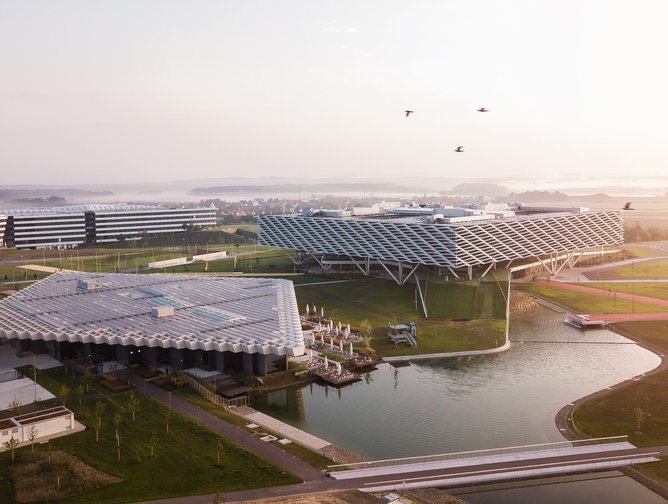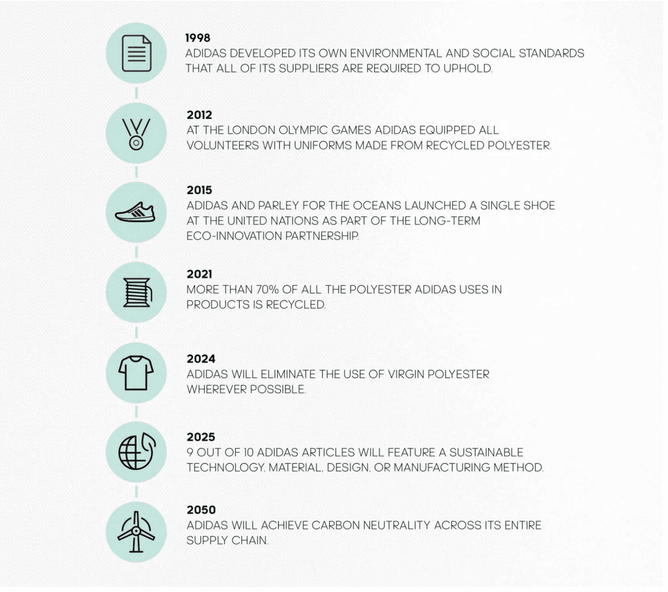How Adidas is Innovating to Make Sportswear More Sustainable

This is an important year for adidas.
As well as celebrating its 75th anniversary in 2024, the sportswear giant is gearing up to make significant sustainable strides as it looks to achieve ambitious 2025 targets.
Committed in the long term to climate neutrality by 2050, the US$36 billion-dollar business has put in place ‘stretch targets’ – 2025 goals focused on topics most material to adidas and its stakeholders.
Among these, to achieve climate neutrality in its own operations and an absolute reduction of Scope 1 and 2 GHG emissions by 90% – along with GHG emissions reduction of 15% per product.
What’s more, by 2025, nine out of 10 adidas articles made by adidas will be sustainable.
“Our company has set very clear targets on what we want to achieve, and we will do exactly that,” says CEO Bjørn Gulden.
“This industry, and especially adidas has done a lot of good stuff for the planet over the last 30 years.”
Starting out in 1949 with just 47 employees in the small town of Herzogenaurach in Germany, adidas has grown to be the largest sportswear manufacturer in Europe and second largest in the world – with 52,000 employees and US$24 billion in annual revenue.

For nearly three decades, adidas has been a change leader in sustainability – among the first to bring eco-innovations to the mass market and the industry's first in publishing a sustainability report.
Powered by its purpose – ‘Through sport, we have the power to change lives’ – the Germany-headquartered company is also a founding member of game-changing initiatives like Better Cotton, Leather Working Group, and Fair Labor Association.
In 2021, adidas doubled down on its commitment to sustainability – defining its all-important roadmap for 2025, which focuses on further material innovation, the switch to cleaner energy sources at supplier facilities, and enabling low-carbon design for its products.

Adidas Innovating to Make Sportswear More Sustainable
In realising its ambition of nine in 10 adidas articles being ‘sustainable by 2025’, the German sports brands focuses on three loops – recycled loop, remade loop and regenerative loop.
'Sustainable’ products are defined as those made mainly from “environmentally preferred materials” – for apparel, at least 70% of the article weight, for accessories (50%) and for footwear (20%).
By the end of 2022, seven out of 10 articles carried a more sustainable material, design, or method of manufacturing, putting the company on track to achieve its goal.
“What we’re doing is we’re looking into different ways of manufacturing our products, different ways of dyeing our materials, different ways of using materials, and actually different materials to use to really bring different products and a more innovative way to life, and make them more sustainable,” Katja Schreiber, Senior Vice-President of Sustainability said recently in a podcast.

Adidas Sourcing Responsibly
When it comes to sourcing responsibly, adidas has committed to more sustainable cotton, with 96.2% of cotton used either certified organic cotton or Better Cotton, while 99.9% of leather used is now third-party certified.
Limiting reliance on virgin forest fibre is also a priority, with a focus on sourcing from Forest Stewardship Council-certified forests.
As such, adidas recently committed to Canopy’s CanopyStyle and Pack4Good initiatives – which are dedicated to eliminating the use of fibre sourced from climate-critical forests in textiles, paper, and paper packaging while promoting the adoption of low-carbon and circular alternatives.
“Adidas is committed to continued high-quality performance of our products whilst delivering meaningful and lasting ecological change for the planet,” says Viviane Gut, Senior Director of Sustainability.
In addressing plastic waste and further adopting low-carbon and circular alternatives, adidas is pushing ahead with recycling initiatives.
Recycling Takes Centrestage on Journey to Sustainability
As the most widely used material, adidas has tackled polyester head-on – achieving its ambitious target to replace all virgin polyester with recycled polyester in all products one year ahead of its 2024 target.
Given that just 15% of polyester produced worldwide is recycled polyester, adidas is leading the apparel industry charge on this.
Among other solutions adidas is pursuing, the repurposing of discarded clothing and agricultural residues into viscose production and paper packaging, respectively.
And the recycling of plastic waste.
Take FUTURECRAFT.LOOP, a 100% recyclable performance running shoe launched in 2015 in collaboration with Parley for the Oceans.
This marked the first performance footwear concept with an upper made entirely of yarns and filaments reclaimed and recycled from marine plastic waste and illegal deep-sea gillnets.
Then in 2019, adidas produced 11 million pairs of shoes containing recycled ocean plastic through intercepting plastic waste on beaches, remote islands and in coastal communities.
Adidas Creating Regenerative Materials
Innovative materials such as bio-based synthetics and more sustainably natural materials are being used on a small scale, as adidas looks to accelerate the development of sustainable materials.
Forging partnerships with companies like Pond, Infinited Fiber, and Spinnova, the brand is focused on developing regenerative materials for use in its products going forward.
In a partnership with Bold Threads, in 2021, adidas released the Stan Smith Mylo – its iconic Stan Smith shoe made from Mylo, a 100% animal-free material, made from mycelium, the underground roots of mushrooms.
Then there’s the prototype Spinnova hoody, made with 75% organic cotton and 25% wood-based fibres, in partnership with Finnish textile material company Spinnova.

The adidas TERREX HS is part of the company’s outdoor brand adidas TERREX, which is leading the innovation of technical materials with the aim of helping drive better product solutions for adventureers in nature.
“Often, we start with a blank sheet of paper,” says Schreiber. “We don’t know what the solution is but we know the direction we want to work towards.”
Another innovative initiative is Choose to Give Back, a resale program designed to extend the life of products. In the United States beginning in October 2021, used shoes, clothes, and accessories, made by any brand and in any condition can be sent to us. Our collaborator, thredUp will resell any products that in good condition.
**************
Make sure you check out the latest edition of Sustainability Magazine and also sign up to our global conference series - Sustainability LIVE 2024
**************
Sustainability Magazine is a BizClik brand






